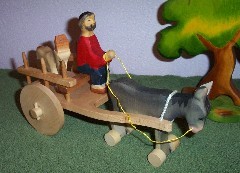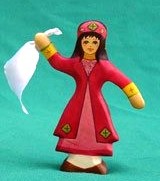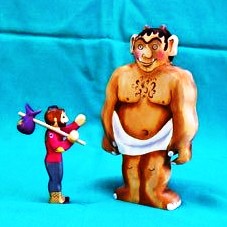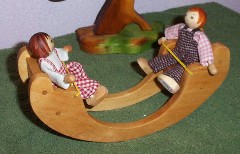
In 1997, two friends, Niko Tsilik and Merab Kuchukhidze, started making wooden toys in Tbilisi, the capital city of Georgia. That’s Georgia the country, not the state. Georgia, which used to be part of the USSR, is an independent nation situated on the Black Sea between Turkey and Russia.
Along with a handful of other workers, mostly relatives, Niko and Merab make a wide range of charming, but simple, wooden toys. Each toy is hand carved from local woods, and painted using food-safe colors. They make toys that are simple enough to inspire imaginative play, but accurate enough to evoke realism.
Niko, who originally had the idea in the 1980s, felt there was a need for simple, well-made wooden toys for children. He met Merab in the late 1990s, and the two of them started the business. For them, it is more than just making toys; it is doing something that is right and helpful for childhood education. The toys are not elaborate or intricately carved, but are clear, simple representations of common themes. Some are solid, while others have moving parts, such as wheels, a working teeter-totter, spinning propellers, and articulated limbs.

Niko and Merab find guiding principles for their intentionally simple toy creations in the philosophy of Rudolf Steiner. Steiner was an Austrian philosopher active in the early 20th century. He is considered the founder of the Waldorf private schools, which remain active today in many countries. On the Waldorf School web page, Barbara Shell explains the idea behind simple toys as follows: “The less finished and the more suggestive a toy may be, the greater its educational value, for it really enlivens the imaginative life of the child.”

At first, Niko and Merab copied things from their own area: tools, buildings, trees and common animals. Eventually the line expanded, and it now includes exotic animals, mythological beasts, trains, airplanes, castles, knights and characters from folk legends, fairy tales and Biblical stories. Some characters display the clothing styles of various indigenous groups, both past and present, while others play out common local lore. One tableau, for example, consists of a woman with a kerchief between two fighters. The story it portrays recounts that in olden times, young men would often duel until a young maiden with a kerchief would throw it between them to end the fight.
Manufacturing is far from easy in that part of Georgia. Electricity comes on only once or twice a day, usually for a couple of hours, and they don’t know when that will be. When they can, they use power tools, but otherwise, most everything is done by hand. Heat is also lacking; these woodworkers must bundle up against the cold. Needless to say, this endeavor does not pay well, and is as much a labor of love as profit.

Their toys first showed up in the United States in large part due to Frank and DoloresRose Dauenhauer. DoloresRose runs the nonprofit Rudolf Steiner bookstore, where many of the Georgian toys grace the shelves. “I have a friend in Vancouver,” DoloresRose explained, “who went to Russia every year with a group of educators and artists to help locals develop educational and arts programs. While in Georgia, she went into a local toy shop and immediately fell in love with these toys. She brought back a few, and I started selling them in the bookstore.” They were so well received that she and her husband decided to import them and soon became the sole distributor in North America.

“I love wood, so it is easy for me to run this business,” said Frank, a hobby woodworker who frequently makes the scenery for his wife’s puppet theater. In addition to the bookstore, DoloresRose runs the Willow Branch Puppet Theater, another nonprofit, and The Pacific Northwest School of Puppetry.
“The Georgians seem to have a knack for making toys that capture the soul of the animals, myths and people that they portray,” said DoloresRose. “The look and feel of the toys inspired us to want to bring these into the country,” Frank added, “and once we brought them in, customers raved about them. We’ve had nothing but positive responses. We’ve never had a return, and nothing but good has come out of it.”





